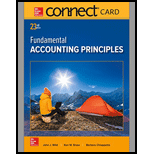
Concept explainers
1)
Introduction:
Activity Based Costing
• Activity Based Costing is a method of cost allocation, whereby costs are assigned to activities performed and cost per unit of activity driver is calculated and assigned to units of activities performed.
• Activity drivers could be cost allocation units such as orders, batches, area occupied etc. Activity based costing favors cost allocation on the actual units of activity carried out as opposed to the standard method of
To Determine:
Overhead activity rate for each activity
2)
Introduction:
Activity Based Costing
• Activity Based Costing is a method of cost allocation, whereby costs are assigned to activities performed and cost per unit of activity driver is calculated and assigned to units of activities performed.
• Activity drivers could be cost allocation units such as orders, batches, area occupied etc. Activity based costing favors cost allocation on the actual units of activity carried out as opposed to the standard method of overhead application using a blanket rate.
To Determine:
Allocate Costs to General Surgery and Orthopedic Surgery and Calculate cost per patient
3)
Introduction:
Cost allocation of Overheads
• Cost allocation of Overheads takes place on basis of cost objects identified to enable cost allocation. Overheads refer to costs of operations and comprise of indirect costs in the form of selling and administrative expenses.
• Examples of Overheads are Salaries of administrative staff, rent of office, advertising expenses etc. The costs of the operations are allocated on basis of cost objects. Cost objects are units of cost allocation identified for overhead allocations and cost estimations.
• Examples of Cost objects for Overhead allocation are Number of units produced, number of labor hours worked etc.
To Determine:
If costs of general surgery per patient, would be higher or lower if costs were allocated across the number of patients.
Want to see the full answer?
Check out a sample textbook solution
Chapter C Solutions
Connect Access Card for Fundamental Accounting Principles

 AccountingAccountingISBN:9781337272094Author:WARREN, Carl S., Reeve, James M., Duchac, Jonathan E.Publisher:Cengage Learning,
AccountingAccountingISBN:9781337272094Author:WARREN, Carl S., Reeve, James M., Duchac, Jonathan E.Publisher:Cengage Learning, Accounting Information SystemsAccountingISBN:9781337619202Author:Hall, James A.Publisher:Cengage Learning,
Accounting Information SystemsAccountingISBN:9781337619202Author:Hall, James A.Publisher:Cengage Learning, Horngren's Cost Accounting: A Managerial Emphasis...AccountingISBN:9780134475585Author:Srikant M. Datar, Madhav V. RajanPublisher:PEARSON
Horngren's Cost Accounting: A Managerial Emphasis...AccountingISBN:9780134475585Author:Srikant M. Datar, Madhav V. RajanPublisher:PEARSON Intermediate AccountingAccountingISBN:9781259722660Author:J. David Spiceland, Mark W. Nelson, Wayne M ThomasPublisher:McGraw-Hill Education
Intermediate AccountingAccountingISBN:9781259722660Author:J. David Spiceland, Mark W. Nelson, Wayne M ThomasPublisher:McGraw-Hill Education Financial and Managerial AccountingAccountingISBN:9781259726705Author:John J Wild, Ken W. Shaw, Barbara Chiappetta Fundamental Accounting PrinciplesPublisher:McGraw-Hill Education
Financial and Managerial AccountingAccountingISBN:9781259726705Author:John J Wild, Ken W. Shaw, Barbara Chiappetta Fundamental Accounting PrinciplesPublisher:McGraw-Hill Education





